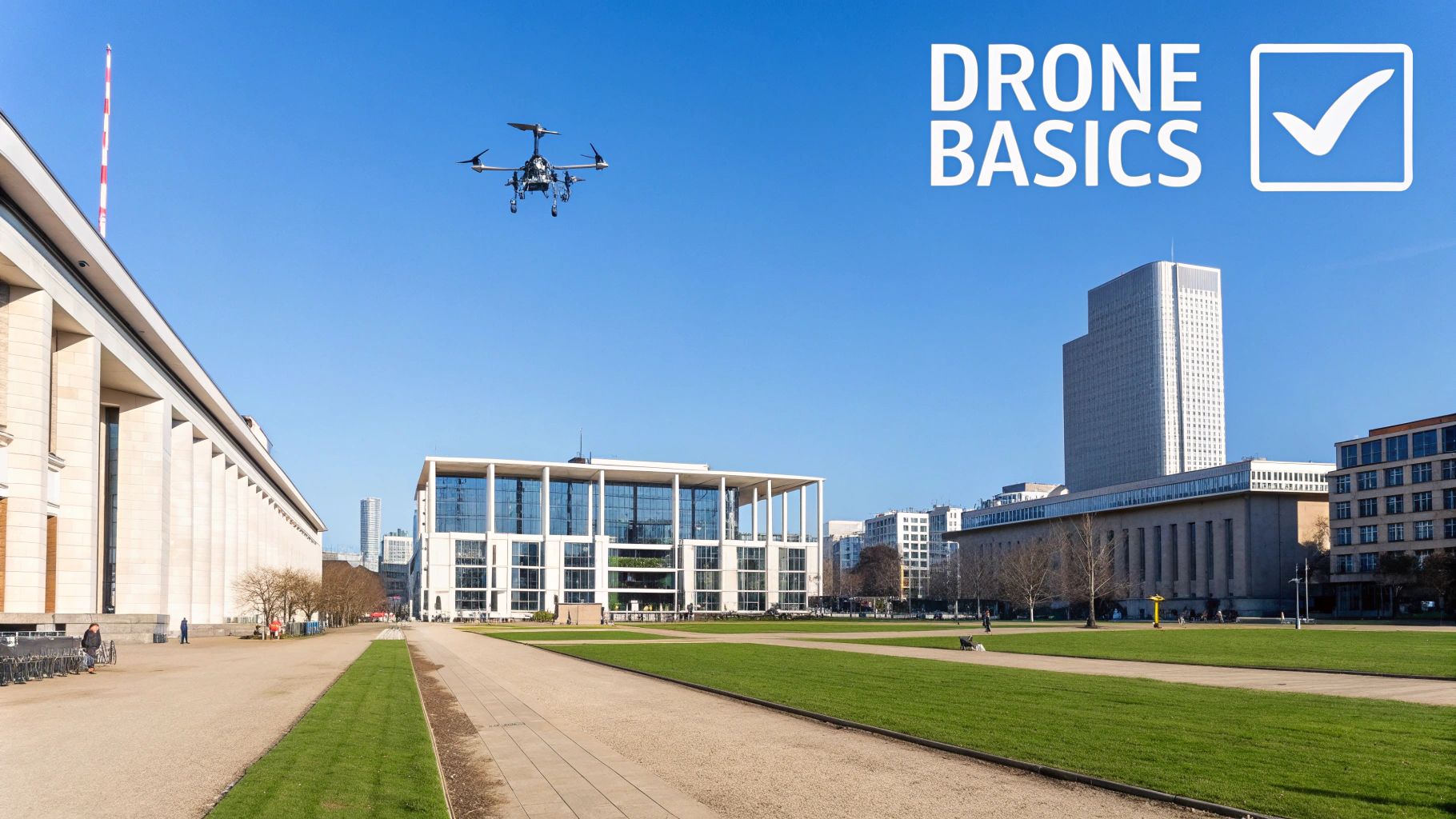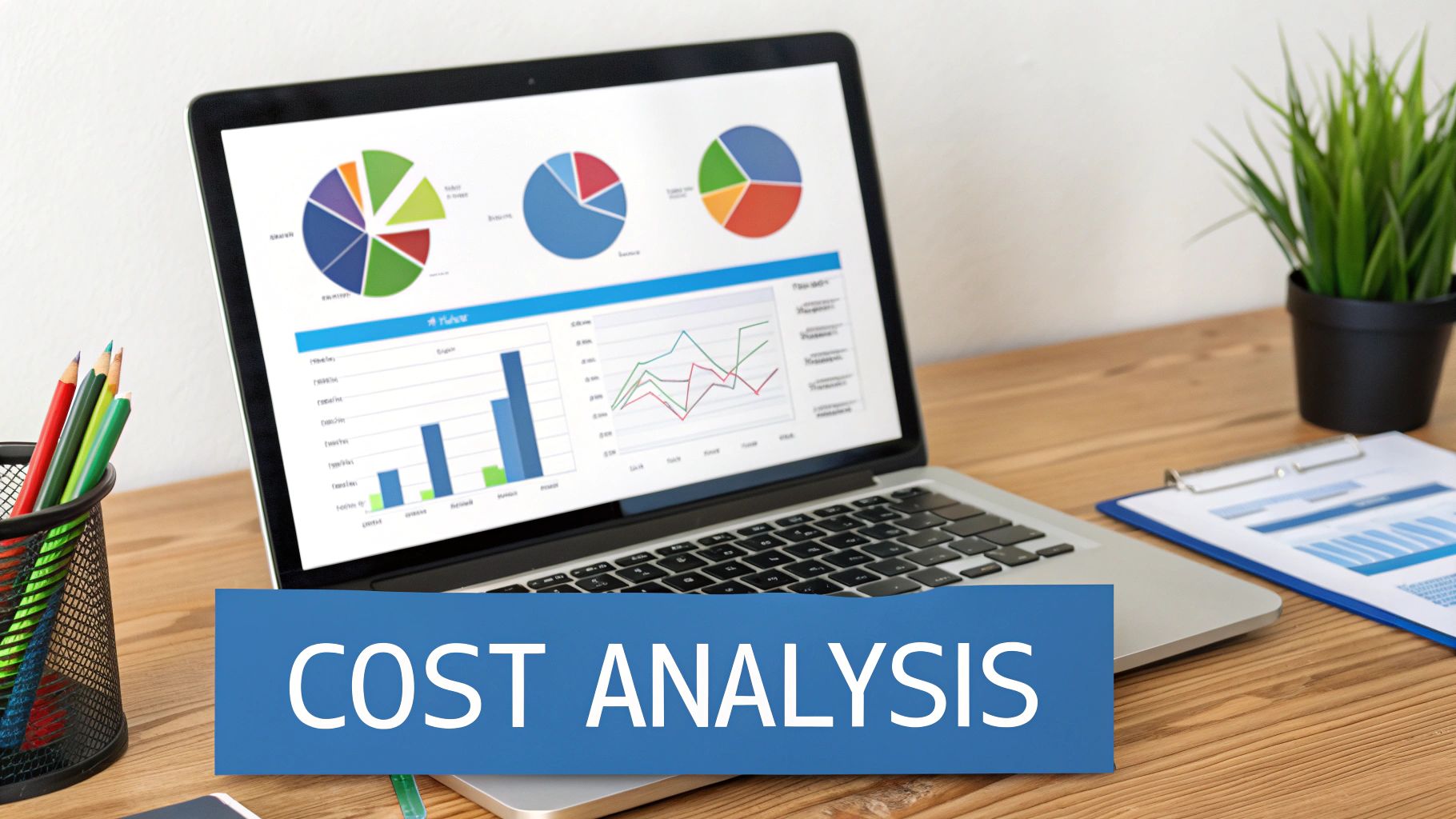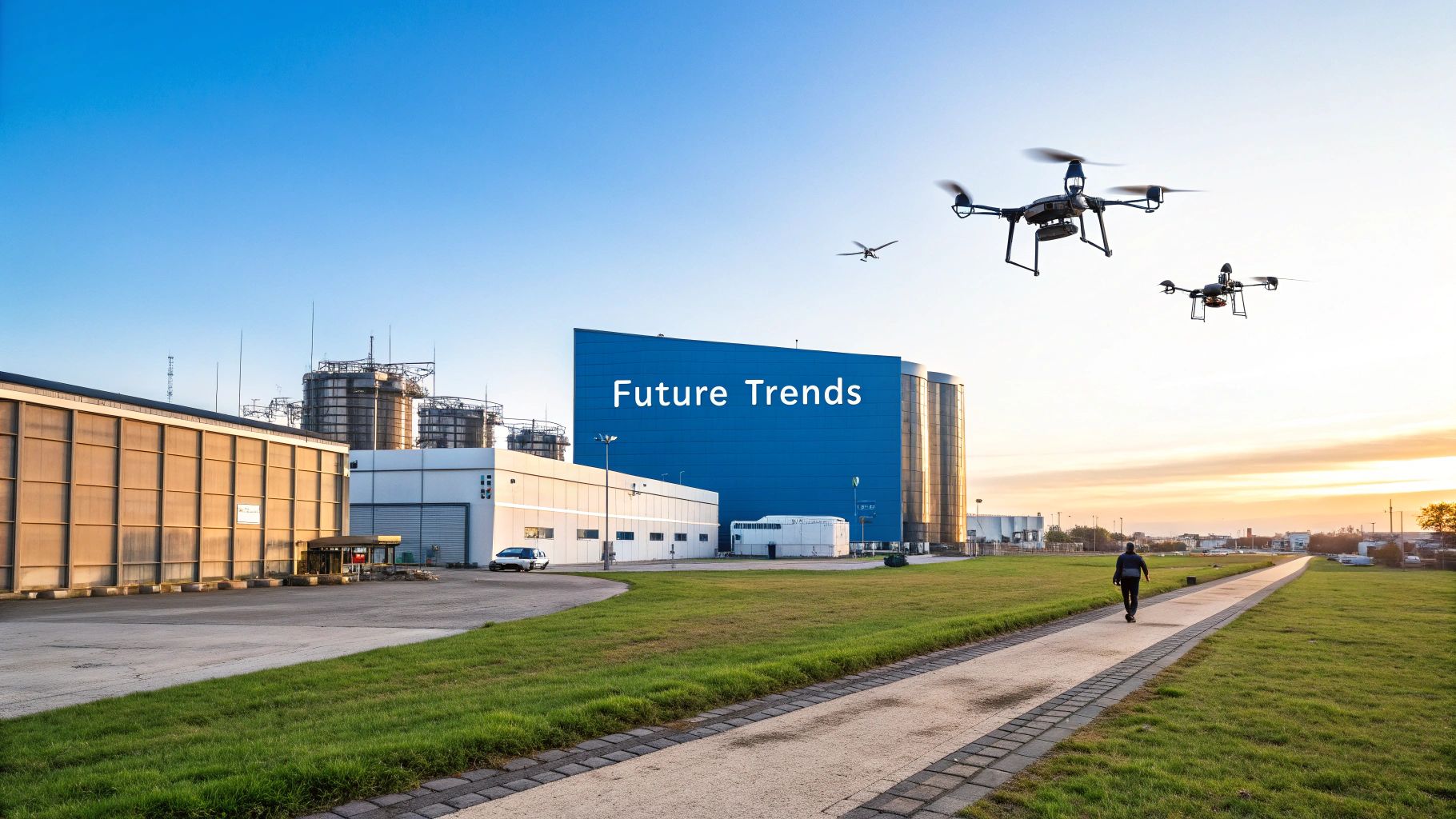Unlock Drone License Cost Secrets for Pilots
- Nickolas Williams

- Apr 18
- 12 min read
The Real Investment Behind Drone Licensing

Getting your drone license isn't just about passing a test; it's an investment in your future as a drone pilot. This investment looks quite different depending on whether you're flying for fun or aiming to make it a career. Understanding these differences is key to setting a realistic budget. For hobbyists, the process usually involves registering your drone with the proper aviation authority, often for a small fee. The real financial commitment comes into play when you decide to fly commercially.
Commercial Drone Operations: The FAA Part 107
Commercial drone operation unlocks exciting possibilities, from capturing stunning aerial photography and videography to conducting infrastructure inspections and agricultural surveys. But this career path requires a more substantial investment: obtaining a commercial drone license. In the United States, this primarily means the FAA Part 107 certification. This license shows you have the knowledge and skills to operate a drone safely and legally for business. Understanding the costs is essential for anyone serious about earning money with their drone.
The core requirement is passing the FAA Part 107 exam, which costs $175 at an FAA-approved testing center. This exam covers topics like airspace classifications, weather interpretation, and drone regulations. Many aspiring drone pilots choose to invest in prep courses to improve their odds of passing on the first attempt. These test prep courses typically run between $199 and $249. For a deeper dive into the costs involved, check out this article: How Much Does It Cost to Become a Drone Pilot in the U.S.. Don't forget to factor in travel expenses to the testing center.
Beyond The Exam: Additional Costs To Consider
The expenses of commercial drone licensing go beyond just the exam fee. Think about study materials, practice tests, and possibly even flight training to prepare for the Part 107 exam. Some people self-study, while others find structured courses more helpful. This can add significantly to the overall cost. Beyond the initial certification, remember the ongoing costs of recurrent training and license renewals. These ensure you stay current with the latest regulations and best practices.
Planning Your Investment
By carefully evaluating both the initial and ongoing costs, you can create a realistic budget for your drone certification journey. This proactive planning ensures you’re financially prepared for a successful career as a commercial drone pilot, turning your passion into a profitable venture. This includes not only the license itself, but also essential equipment and insurance – all crucial aspects of your overall investment.
Part 107 Certification: What You'll Actually Spend

So, you're ready to become a certified drone pilot? That's fantastic! Before you begin, it's essential to understand the financial commitment involved in obtaining your Part 107 license. It's more than just the exam fee. Let's break down the expenses you should anticipate for your FAA Part 107 Remote Pilot Certificate.
Understanding The Costs
The initial exam fee is $175. However, the overall drone license cost often includes more. Many aspiring pilots choose to invest in prep courses, ranging from $199 to $249. These courses typically offer structured learning, practice tests, and helpful resources.
Some prefer self-study, using free online materials and study guides. This route requires significant self-discipline. Setting aside consistent study time and regular practice is crucial for success with this approach. This leads us to other potential costs.
Hidden Costs
Beyond the exam and prep courses, factor in the cost of study materials, such as textbooks or online resources. Practice exams, while sometimes bundled with prep courses, may incur additional costs.
Travel to the testing center is another expense to consider. Depending on your location, you might have gas, tolls, or even airfare. For some, travel can add a substantial amount to the total drone license cost.
Recertification: Maintaining Your License
Obtaining your license is just the beginning. Every two years, you'll need to recertify. This requires completing a recurrent knowledge test, currently priced at $50. This process ensures you stay updated on the latest regulations and best practices. Recertification is essential for maintaining your credentials and continuing commercial drone operations. For more on drone piloting, check out JAB Drone's sitemap.
Cost Breakdown Summary
The following table summarizes the expenses associated with obtaining and maintaining an FAA drone license. This detailed breakdown helps prospective pilots plan their budget and avoid any surprises.
FAA Part 107 Certification Cost Breakdown: Detailed breakdown of all expenses related to obtaining and maintaining an FAA drone license
Expense Item | Cost Range | Frequency | Notes |
|---|---|---|---|
Part 107 Exam Fee | $175 | One-time | Non-refundable |
Prep Course | $199 - $249 | One-time (per attempt) | Optional, but recommended |
Study Materials | Variable | One-time or as needed | Depends on study method |
Practice Exams | Variable | As needed | Can be included in prep courses |
Travel Expenses | Variable | Per exam attempt & recertification | Depends on location of testing center |
Recertification Fee | $50 | Every 2 years | Required to maintain certification |
Understanding the complete financial picture beforehand allows you to approach your certification journey with confidence. Planning for these costs will help you smoothly navigate the process of becoming a certified drone pilot.
The Equipment Investment: Beyond Just Buying a Drone

So, you've earned your Part 107 certificate. Congratulations! This is a major step towards becoming a drone pilot. But before you take to the skies, it's important to understand the financial commitment that goes beyond the initial certification. Getting your drone license is just the first investment. Equipping yourself for successful drone operations involves a whole other set of costs.
Essential Gear: More Than Just the Aircraft
Many new pilots start with entry-level drones, often opting for models like the DJI Mini 2 or Mini 3. These typically range between $449 and $759. But the drone itself is only the beginning. Essential accessories like extra batteries, memory cards, and propeller guards can easily add another $150 to $250 to your initial expenses. Find more detailed statistics here. As your operations become more complex, you'll need to invest in specialized equipment for specific commercial applications.
Matching Equipment to Your Mission
Different commercial drone uses require different capabilities. Real estate photography, for instance, demands high-resolution cameras and stable flight. Industrial inspections, on the other hand, often benefit from thermal imaging and obstacle avoidance systems. Knowing your target market and the type of work you'll be doing is essential for choosing the correct drone.
This specialized equipment naturally impacts the overall investment. A basic drone for aerial photography won't cost as much as a professional system for complex mapping or industrial inspections. Understanding these different tiers of investment is vital for effective budgeting.
To illustrate the different costs associated with drone equipment, let's take a look at a comparison table. This table outlines the potential expenses for essential drone equipment at varying budget levels.
Essential Drone Equipment Cost Comparison:
Equipment Category | Budget Option | Mid-Range Option | Professional Option |
|---|---|---|---|
Drone | DJI Mini 2 ($449) | DJI Air 2S ($999) | DJI Matrice 300 RTK ($10,999) |
Batteries (2 Extra) | $100 | $200 | $500 |
Memory Card (128GB) | $25 | $50 | $100 |
Propeller Guards | $20 | $40 | $80 |
Carrying Case | $30 | $60 | $120 |
Software (Annual Subscription) | $0 (Free options available) | $100 (DroneDeploy) | $500 (Pix4D) |
Total Estimated Cost | $624 | $1,449 | $12,399 |
As you can see, the cost of drone equipment can vary significantly depending on your chosen setup. From a budget-friendly option to a professional-grade system, planning your investments wisely is critical.
Hidden Costs: The Unexpected Expenses
Beyond the initial outlay for the drone and basic accessories, there are other expenses to consider. These "hidden costs" can often surprise new drone pilots.
Software Subscriptions: Flight planning, data analysis, and post-processing often require specialized software, which can come with recurring subscription fees.
Backup Equipment: Experienced pilots often invest in backup drones, batteries, and other vital components to minimize downtime in case of equipment failure.
Maintenance and Repairs: Drones require regular maintenance and occasional repairs, which can be unpredictable expenses.
Strategic Planning: Balancing Needs and Growth
Smart planning is key to navigating the equipment landscape. Some purchases, like safety gear, are non-negotiable from day one. Other items, like specialized payloads or high-end software, can be added later as your business expands. Learning from experienced drone operators can help you prioritize investments and avoid unnecessary early spending.
Building Your Equipment Roadmap
A strategic acquisition plan is crucial for managing your drone business finances. Here’s a suggested approach:
Defining Your Core Services: What will your drone business offer? What is your target market?
Matching Equipment to Those Services: Based on your services, what equipment is absolutely necessary, and what can wait?
Prioritizing Purchases: Separate your needs from your wants. What must you buy now, and what can be purchased later?
Budgeting for Maintenance and Upgrades: Drones require upkeep. Factor these costs into your financial planning.
By understanding the full scope of equipment costs, you'll be better equipped to make smart financial decisions. Balancing your initial drone license cost and equipment needs with your long-term business goals is essential for success.
Protecting Your Investment: Insurance Realities

Getting your Part 107 license and investing in a drone is a big step toward a rewarding career. But protecting that investment with the right insurance is equally important for your long-term success. Many new pilots don't fully grasp the need for comprehensive coverage. This section explores why drone insurance is essential, not a luxury.
Understanding Drone Insurance
Drone insurance protects your business from unexpected incidents. These can range from accidental damage to your drone (hull coverage) to liability claims for property damage or personal injury caused by your drone. Think of it like car insurance from companies like State Farm – it provides financial protection if something goes wrong.
Different types of coverage address different needs. Liability insurance is often the most crucial, protecting you against claims from others. Hull insurance covers damage to your own drone, whether from a crash or equipment malfunction. Some policies even cover data loss, which is important for commercial work.
The Cost of Coverage
Drone insurance, while optional, is strongly recommended. It can cost between $500 and $750 per year. Factoring in these costs, new commercial drone pilots in the U.S. face total upfront investments ranging from approximately $1,543 to $2,482, not including recurring expenses like insurance renewals. Find more detailed statistics here. Premiums depend on factors like your experience, the type of drone you fly, and the kind of work you do. Higher-risk operations, such as flying over populated areas, generally mean higher premiums.
The Consequences of Inadequate Coverage
Flying without enough insurance can have devastating financial consequences. Imagine your drone malfunctioning and damaging property or, even worse, injuring someone. The resulting legal fees and settlements could cripple your business. Even a minor crash can lead to significant repair or replacement costs without insurance. You can also visit JAB Drone's Sitemap for more information about drones.
Choosing the Right Policy
Selecting the right drone insurance policy takes careful thought. Consider your particular needs and the risks involved in your operations. For example, if you mainly fly over rural areas, your needs will differ from someone flying in cities. Key factors to consider include:
Coverage Limits: How much coverage is needed for liability and hull damage?
Deductibles: How much are you willing to pay out-of-pocket if you make a claim?
Exclusions: What situations aren't covered by the policy?
By carefully weighing your options and choosing appropriate coverage, you can protect your investment and ensure the long-term success of your drone business. This proactive approach to insurance offers peace of mind, allowing you to focus on flying.
Global Perspective: What Drone Pilots Pay Worldwide
The cost of a drone license varies significantly around the world. Just as drone regulations differ from one country to the next, so too do the associated costs and processes for obtaining a license. This global perspective is essential for pilots considering international operations or competing with operators from other countries. Understanding these differences helps put the costs of obtaining a license in the United States into context. You might be interested in: JAB Drone's blog categories.
Licensing Costs: A World of Difference
Some countries have minimal licensing requirements for basic drone operations, especially for recreational flyers. However, countries with more developed drone industries often have stricter rules and higher fees. These varying regulatory frameworks directly impact the initial investment required for drone businesses worldwide. Training requirements, exam fees, and equipment restrictions all contribute to the overall cost of operating drones legally.
For example, in some European countries, the cost of a drone license can be considerably more expensive than in the U.S., including comprehensive training and practical exams. This higher cost is often reflected in the price of drone pilot training programs, which can reach thousands of dollars. In contrast, some regions have simpler processes with lower associated costs, potentially making it easier to enter the drone industry. The drone industry’s rapid global expansion has influenced licensing and operational costs in major markets.
China, for example, dominates civilian drone manufacturing, holding over 70% of the global market share. By the end of 2023, China had registered about 1.27 million licensed Unmanned Aerial Vehicles (UAVs), a 32.2% increase from 2022. Find more detailed statistics here. This rapid growth has fueled innovation but also added complexity to regulations.
Navigating International Regulations
Operating drones internationally presents additional challenges. Every country has its own specific set of regulations, meaning a license obtained in one country may not be valid in another. Pilots planning international operations must carefully research and comply with the rules of each location where they intend to fly. This frequently involves obtaining separate licenses and understanding different airspace restrictions.
Competitive Landscape: International Considerations
Understanding international drone license costs is key for competitive analysis. For U.S.-based operators, knowing the costs faced by competitors in other countries provides valuable insights into their market positioning. This knowledge allows for more strategic pricing and service offerings. A company operating in a region with lower licensing costs, for instance, might be able to offer more competitive rates. This underscores the importance of having a global perspective in the drone industry.
Opportunities and Challenges
While navigating international drone regulations can be complex, it also presents unique opportunities. Some regions with more favorable licensing structures or less competition may offer attractive markets for expansion. However, succeeding in these markets requires a deep understanding of local regulations and a willingness to adapt operations accordingly. This includes not only the drone license cost, but also the cultural and logistical aspects of doing business in that specific location. A global perspective provides valuable insights for any drone pilot seeking to expand their operations and thrive in the dynamic international drone market.
From Investment To Income: Recouping License Costs
After understanding the costs associated with obtaining a drone license, the next logical question is: how can you earn back that investment? This section explores the income potential for commercial drone pilots and how you can recoup your drone license costs through various business ventures.
Realistic Earnings Potential
The earning potential for commercial drone pilots varies depending on several factors, including your chosen area of expertise, your location, and your business skills. Some common drone services include:
Real Estate Photography: This popular entry point offers decent income potential with relatively low startup costs.
Industrial Inspections: Inspecting cell towers, power lines, and other infrastructure can be lucrative, but often requires specialized equipment and training.
Agricultural Surveys: Skilled pilots can earn well providing mapping and analysis services to farmers using drones.
Construction and Engineering: Monitoring construction progress, creating 3D models, and surveying land are in-demand services within the construction sector.
Pricing Models For Profitability
Choosing the right pricing model is essential for maximizing your earnings. Here are a few commonly used models:
Per Deliverable: Charge a fixed fee for a specific product, like a set of real estate photos or an inspection report.
Flight Hour: Charging by the hour works well for projects with variable time requirements, such as aerial videography or large-scale mapping.
Subscription: Offering subscription packages for recurring services, like regular agricultural monitoring, provides a steady income stream.
Market Factors Influencing Earning Potential
Several market factors influence your potential earnings:
Geographic Location: Areas with higher demand for drone services, such as large cities or industrial centers, generally offer better income potential.
Specialization: Focusing on a niche market with less competition, like specialized inspections or aerial cinematography, can command higher fees.
Competitive Positioning: Effective marketing, a strong portfolio, and excellent customer service are crucial for attracting clients.
Accelerating Your Break-Even Point
Recouping your drone license cost quickly requires a strategic approach:
Targeted Marketing: Focus your marketing on the specific industries and clients you want to serve.
Networking: Building relationships with potential clients and industry professionals can lead to valuable opportunities.
Value-Added Services: Offering additional services, such as data analysis or post-processing, can boost your earnings.
Efficient Operations: Streamlining your workflow and minimizing expenses helps you reach profitability faster.
Aligning Costs With Business Objectives
Before starting your drone business, carefully evaluate if the drone license cost and related expenses align with your revenue expectations and long-term business goals. A detailed business plan, including projected earnings and expenses, helps you assess the financial viability of your venture. Consider factors like insurance, equipment maintenance, and continuing education. By carefully balancing your investment with your earning potential, you can ensure a profitable career as a commercial drone pilot.
The Long Game: Ongoing Costs of Drone Operations
Successfully launching a drone business involves more than just the initial investment. Beyond the drone itself and the Part 107 license, smart entrepreneurs also account for the ongoing expenses that impact long-term financial sustainability. Understanding these costs is key to building a profitable and resilient drone operation.
Maintaining Your Equipment and Skills
Drones, like any complex piece of equipment, require regular maintenance to ensure reliable performance. This includes routine tasks like cleaning, calibrating sensors, and replacing worn parts. Think of it like owning a car – regular upkeep is essential.
Battery Replacement: Drone batteries have a limited lifespan and will need periodic replacement. This is a recurring expense that should be factored into your budget.
Repairs and Replacements: Accidents happen, even to the most experienced drone pilots. Budgeting for repairs, or even a full drone replacement, is crucial for long-term financial stability.
Beyond hardware maintenance, staying current with evolving drone technology is essential. New models and software are constantly emerging, and investing in upgrades helps you remain competitive and offer the best services. Continuing education, through workshops and online resources, is also important for staying ahead of the curve.
Recertification and Regulatory Costs
Your drone license isn't a one-time expense either. Part 107 certification in the United States requires recurrent knowledge testing every two years. This ensures pilots stay up-to-date with regulations and best practices.
Regulatory Changes: As the drone industry continues to mature, regulations are likely to evolve. This could lead to new licensing requirements or fees. Staying informed about these potential changes can help you avoid unexpected costs and maintain compliance.
Building a Sustainable Business
By understanding these ongoing costs upfront, you can develop a more accurate and comprehensive business plan. This proactive approach to budgeting will contribute to the long-term viability of your drone operation.
Reserve Funds: Setting aside a portion of your revenue for equipment maintenance, repairs, and future upgrades can help you avoid cash flow problems down the line. This creates a financial cushion to handle unexpected expenses and allows for strategic investments in your business.
Ready to take your drone business to new heights? JAB Drone offers a wealth of resources and insights for drone enthusiasts and professionals. Explore expert reviews, stay updated on the latest drone news, and connect with a passionate community of drone pilots.




Comments